Syracuse, New York Blood Testing Facilities
 Represents a LabCorp blood testing facility
Represents a LabCorp blood testing facility Represents a Quest Diagnostics blood testing facility
Represents a Quest Diagnostics blood testing facility
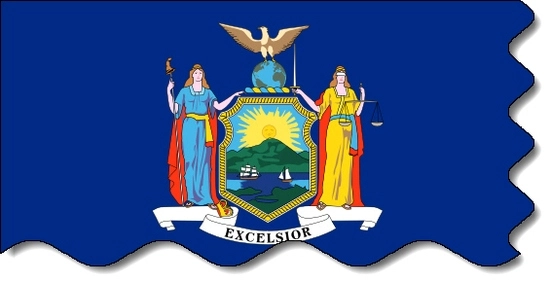
Nearby Labcorp Blood Testing facilities:
- Labcorp Center Distance: 4 m, 5100 W Taft Rd Ste 2L, Liverpool, Onondaga County, NY, 13088
- Labcorp Center Distance: 5 m, 4939 Brittonfield Parkway, East Syracuse, Onondaga County, NY, 13057
- Labcorp Center Distance: 8 m, 8100 Oswego Rd Ste 125, Liverpool, Onondaga County, NY, 13090
- Labcorp Center Distance: 22 m, 37 W Garden St Ste 204, Auburn, Cayuga County, NY, 13021
- Labcorp Center Distance: 25 m, 603 Seneca St Lwr Lvlrear Dr, Oneida, Other, NY, 13421
- Labcorp Center Distance: 37 m, 1614 N James St, Rome, Oneida County, NY, 13440
- Labcorp Center Distance: 38 m, 91 Perimeter Rd, Rome, Oneida County, NY, 13440
- Labcorp Center Distance: 41 m, 8411 Seneca Tpke, New Hartford, Oneida County, NY, 13413
- Labcorp Center Distance: 43 m, 37 Main St, Whitesboro, Oneida County, NY, 13492
- Labcorp Center Distance: 44 m, 1656 Champlin Ave, Utica, Oneida County, NY, 13501
- Labcorp Center Distance: 45 m, 1904 Genesee St, Utica, Oneida County, NY, 13502
- Labcorp Center Distance: 50 m, 7980 State Route 12, Barneveld, Oneida County, NY, 13304
- Labcorp Center Distance: 59 m, 201 East State St, Herkimer, Herkimer County, NY, 13350
- Labcorp Center Distance: 63 m, 19436 Howell Dr Unit 2, Watertown, Other, NY, 13601
- Labcorp Center Distance: 73 m, 200 Madison Ave-Hlth Ser Bldg, Elmira, Chemung County, NY, 14901
- Labcorp Center Distance: 88 m, 102 Union Street, Cobleskill, Schoharie County, NY, 12043
Nearby Quest Blood Testing facilities:
- Quest Center Distance: 0 m, 1000 East Genesee St, Syracuse, Onondaga County, NY, 13210-1885
- Quest Center Distance: 2 m, 396 Grant Blvd., Syracuse, Onondaga County, NY, 13206-2601
- Quest Center Distance: 4 m, 4820 W Taft Rd, Liverpool, Onondaga County, NY, 13088-2806
- Quest Center Distance: 6 m, 5366 W Genesee St, Camillus, Onondaga County, NY, 13031-2252
- Quest Center Distance: 8 m, 5586 Legionnaire Dr, Cicero, Onondaga County, NY, 13039-3504
- Quest Center Distance: 11 m, 138 E Genesee St, Baldwinsville, Onondaga County, NY, 13027-2720
- Quest Center Distance: 14 m, 225 Genesee St, Chittenango, Madison County, NY, 13037-1704
- Quest Center Distance: 30 m, 6 Euclid Ave, Cortland, Cortland County, NY, 13045-1257
- Quest Center Distance: 38 m, 1790 Black River Blvd, Rome, Oneida County, NY, 13440-2454
- Quest Center Distance: 42 m, 2309 North Triphammer Road, Ithaca, Tompkins County, NY, 14850-0000
- Quest Center Distance: 45 m, 2002 Genesee St, Utica, Oneida County, NY, 13502-5628
- Quest Center Distance: 64 m, 345 Harry L Dr, Johnson City, Broome County, NY, 13790-1404
- Quest Center Distance: 90 m, 86 Briggs St, Johnstown, Fulton County, NY, 12095-1566
- Quest Center Distance: 99 m, 1340 Riverfront Center, Amsterdam, Montgomery County, NY, 12010-4610
New York Hormone Replacement Therapy Solutions
The Conscious Evolution Institute specializes in Hormone Optimization and HRT Services for adults over the age of thirty. Hormone Deficiency is one of the biggest contributors to the aging process, as well as one of the most preventable. Our clinic has a fully licensed and board certified panel of Health and Wellness physicians that specialize in Anti-Aging and Hormone Restoration. With our help, we can help you get back on track and make the most of your golden years!
New York HGH Therapy
Do you feel like your body is slowing down as you grow older? Are you gaining weight and losing muscle mass without any changes in your day-to-day routine? You may be suffering from a condition known as Adult-Onset Growth Hormone Deficiency.
HGH Deficiency is a treatable disorder which speeds up many processes associated with aging, and is one of the leading causes of premature aging. With a simple doctor's appointment and blood test, we can diagnose your deficiency and arrange for high-quality HGH Injections to be shipped straight to your office or home.
New York Sermorelin Acetate Therapy
Growth Hormone Injections are a highly effective means to treat Growth Hormone Deficiency, but we also offer Sermorelin Injections. These shots have the ability to boost HGH levels by stimulating the brain to create more of the vital hormone. The body still effectively modulates production, preventing the risk of overdose while still providing youthful concentrations of Human Growth Hormone.
New York Low-T Treatments
We also provide Testosterone Replacement Therapy for both men and women suffering from issues related to Testosterone Deficiency. Testosterone is the primary hormone responsible for male sexual desire and function, and without it, libido decreases profoundly, and erectile dysfunction becomes an unavoidable issue. With simple Testosterone Replacement Therapy, we can boost your Testosterone Levels, which can improve your sex life, as well as reduce the risk of a number of medical issues related to Low-T, including diabetes, fatigue, and obesity.
Women can also benefit from Testosterone Replacement. Testosterone is responsible for feminine libido and sexual function, and for women having trouble in the bedroom, a low-dose Testosterone supplement can get you back in the saddle.
New York HCG for Weight Loss
If you have trouble losing weight and keeping it off, HCG Injections may be your best hope for overcoming the risks of obesity. HCG, when combined with a structured, low-calorie diet, can help you lose more than five pounds per week. HCG is an incredibly effective diet, because it quietens the hunger pangs associated with caloric restriction while also priming the body to burn stubborn belly fat. With our help, you can overcome your weight issues and become a thinner, happier, and healthier you!
Major Cities in New York
New York City
New York City is both the largest city in the United States as well as the country as a whole. New York was incorporated in its current form in 1898, when the five boroughs of New York: Manhattan, Brooklyn, the Bronx, Queens, and Staten Island, voted to consolidate into a single, larger city. Today, that city has evolved into arguably the most important city on earth.
Each borough has its own particular identity. Manhattan is known for its financial sector, and is the home of both Broadway and the United Nations Headquarters. Queens is known for its unparalleled diversity, with residents from all over the globe. Staten Island is like a suburban bedroom community which lay across the Hudson Bay from Manhattan. Brooklyn is known for its unique identity and attitude, and most of its residents commute to Manhattan for work. The Bronx has been classically known as the Concrete Jungle, and is home to the Yankees and the Bronx Zoo.
Buffalo
Buffalo, New York is the second most populous city in New York, and is located on Lake Erie, immediately across the border from Canada. Buffalo is the closest major American city to both Toronto and Hamilton, Ontario. Buffalo is also home to the Erie Canal, which led directly to its development as a major American city. Buffalo is located just to the south of Niagara Falls, one of the premier, natural tourist attractions in the United States. Buffalo is home to two professional sports teams, the NHL Buffalo Sabres, and the NFL Buffalo Bills
Rochester
Rochester is the third largest city in New York, and is located on the southern shore of Lake Ontario. Rochester is an important research city, and is home to both the Rochester Institute of Technology and the University of Rochester.
Because of its prominence as an international research center, Rochester has a strong economy, and is home to a number of successful companies, including Xerox, Bauch and Lomb, and Kodak. Because of its strong economy and high quality of life, Rochester is frequently listed among the most livable major cities in the United States.
Yonkers
Yonkers is the fourth most populated city in the state of New York, and lies in the New York City Metropolitan Area, immediately to the north of the Bronx. Yonkers is often referred to as the Sixth Borough, because of its close proximity to New York City. Yonkers actually had the opportunity to become a member of NYC in 1898, but the voters declined, and the city remains independent today.
Yonkers has a number of popular tourist attractions, including Science Barge, Sherwood House, the Hudson River Museum, and Getty Square.
Syracuse
Syracuse is located in central New York State, and is the fifth most populous city in the state. The city is commonly referred to by the nicknames of The Heart of New York and the Emerald City. It is home to Syracuse University.
Historically, Syracuse has had a strong manufacturing presence, but in recent decades, those opportunities have declined and have given way to education and service industry as the primary economic powerhouses. In spite of this decline, Syracuse is still widely considered one of the best places in the United States to start and raise a family.
All About Syracuse, New York Geographic Area
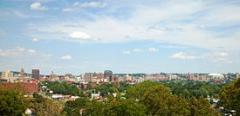
Syracuse ( /ËnsɪrÉokjuËas/ or local /ËnsÉorÉokjuËas/) is a city in and the county seat of Onondaga County, New York, United States. It is the largest U.S. city with the name "Syracuse", and is the fifth most populous city in the state of New York. At the 2010 census, the city population was 145,170, (making it the 167th largest city in the country) and its metropolitan area had a population of 662,577. It is the economic and educational hub of Central New York, a region with over a million inhabitants. Syracuse is also well-provided with convention sites, with a downtown convention complex and, directly west of the city, the Empire Expo Center, which hosts the annual Great New York State Fair. The city derives its name from Siracusa, a city on the eastern coast of the Italian island of Sicily.
/ËnsɪrÉokjuËas/ or local /ËnsÉorÉokjuËas/) is a city in and the county seat of Onondaga County, New York, United States. It is the largest U.S. city with the name "Syracuse", and is the fifth most populous city in the state of New York. At the 2010 census, the city population was 145,170, (making it the 167th largest city in the country) and its metropolitan area had a population of 662,577. It is the economic and educational hub of Central New York, a region with over a million inhabitants. Syracuse is also well-provided with convention sites, with a downtown convention complex and, directly west of the city, the Empire Expo Center, which hosts the annual Great New York State Fair. The city derives its name from Siracusa, a city on the eastern coast of the Italian island of Sicily.
The city has functioned as a major crossroads over the last two centuries, first between the Erie Canal and its branch canals, then of the railway network. Today, Syracuse is located at the intersection of Interstates 81 and 90, and its airport is the largest in the region. Syracuse is a home to Syracuse University, a major research university; the Upstate Medical University and Hospital, the city's largest employer; SUNY Environmental Science and Forestry and other colleges and professional schools. In 2010 Forbes rated Syracuse 4th in the top 10 places to raise a family.

Around 399 million years ago, during the middle Devonian Period, the land now occupied by the city of Syracuse was south of the equator and covered by a salty sea. Eventually, the sea water evaporated leaving behind layers of halite and seashells which were eventually buried in the earth. From this prehistoric period, two products emerged as major resources in the 19th century; salt and limestone.
Many geological events occurred over the centuries which shaped the land. The most recent was the Great Ice Age which took place approximately 20,000 years ago. The last sheet of ice formed the Finger Lakes, the Adirondack Mountains, and Onondaga Lake, in addition to other land formations in Upstate New York.
The land around Onondaga Lake had been inhabited by Native Americans for 4,000 to 5,000 years. The Five Nations of the Iroquois Confederacy was composed of the Mohawks, the Senecas, the Onondagas, the Oneidas, and the Cayugas. Each nation's territory is located in what is now New York State. The Onondagas lived in the area around Onondaga Lake in Central New York.
By 1722, the Tuscarora people joined with the Iroquois and the confederacy then became known as the Six Nations.
The first known Europeans in the area were the French who arrived in 1615 when Samuel de Champlain launched an attack against the Onondagas with the aid of the Huron and Algonquian Indians who were bitter enemies of the Iroquois. Champlain's attack of the Onondaga fortress, the location of which has been heavily debated, but is now believed to have been located at the head of Onondaga Lake, lasted six days and ended when Champlain withdrew wounded and defeated.
During the 1640s, which were years of "troubling" battles between the French, Huron and Iroquois, many Jesuit priests were killed. Many French missionaries who arrived in the area from Canada, retreated to the north.
On August 5, 1654, Father Simon LeMoyne, a Jesuit missionary, arrived in the Onondaga village. During his short stay, LeMoyne drank from a spring which the Onondagas believed to be foul due to an evil spirit. He found it to be a salt water spring and he returned to Canada with salt made from the spring water.
A French mission, Sainte Marie Among the Iroquois, or Ste. Marie de Gannentaha, was established in the summer of 1656, on Onondaga Lake.
The British began to take an active interest in the land around Onondaga Lake in the early 1700s. They befriended the Onondagas by giving them guns, which were highly prized. A British agent, William Johnson, acquired 200,000 acres (810,000,000 m2) of land in the Mohawk country near present day Johnstown, New York. In 1751, Johnson heard that the French intended on securing a military post in the vicinity of the salt springs. He discussed the consequences of that action with the Onondagas and proposed that they grant him rights to all of Onondaga Lake and a two-mile (3 km) band of land around it. The Onondagas agreed and were paid E350 sterling.
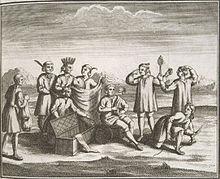
As the Revolutionary War approached, both the British and the Americans sought Iroquois support. The British succeeded and by the end of the war, only the Oneidas and Tuscaroras, a recent addition to the nation, had remained neutral or friendly to the Americans.
The end result of the American Revolutionary War was the Treaty of Fort Stanwix (1784) enacted by the United States on October 22, 1784. The lands of the natives were distributed by treaties soon after. In 1788, the lands around Onondaga Lake were transferred from the Onondaga Nation to local salt producers.
The Oneidas and the Tuscaroras were able to secure the lands which they inhabited. Offers of reservations were made to the four nations that opposed the Americans. The Onondagas, Senecas, and Cayugas accepted the offer. The Mohawks refused and sought refuge in Canada similar to other British sympathizers.
In later years the Onondagas began selling their land in order to gain items brought by white men to the area. Their reservation diminished slowly over time.
After the American Revolutionary War, more settlers came to the area, mostly to trade with the Onondaga Nation. Ephraim Webster left the Continental Army to settle in 1784, along with Asa Danforth, another participant in the war. Comfort Tyler, whose engineering skill contributed to regional development, arrived four years later. All three settled in Onondaga Hollow south of the present city center at the head of Onondaga Lake, which was then marshy.

In late 1788, after the enactment of the Treaty of Fort Stanwix (1784) in which the Onondaga Nation relinquished part of their reservation including Onondaga Hollow to the local salt producers. The land was now open to settlers and the natives were left with only hunting and fishing rights. Tyler and Danforth began making salt for the family, but did not produce it to sell. Danforth built a sawmill and gristmill and Tyler laid the first roads and built bridges, and in the future would support the building of churches and schools.
The ground upon which the city of Syracuse now stands was originally part of the Onondaga Salt Springs Reservation. The first locality which received a name was called Webster's Landing after early settler, Ephraim Webster who was an Indian trader on the banks of the Onondaga Creek.
By 1793, the Westside of the future city was described as "dark, gloomy, and almost impenetrable swamp that was a favorite resort for wolves, bears, wildcats, mud-turtles, and swamp rattlesnakes." The western portion of the valley about Syracuse was originally timbered with hemlock, birch and soft maple; the eastern portion with cedar and pine.
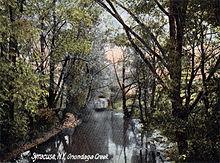
During 1804, an act was passed that directed the sale of 250 acres (1,000,000 m2) of the Onondaga Salt Springs Reservation for the purpose of "laying out and improving a road" running from lot 49, Manlius, to lot 38, Onondaga, east and west through the reservation. James Geddes laid out the design of the new road in "rather an irregular form so that as much dry land might be secured as possible." The land, now the central portion of the city of Syracuse, was purchased by Abraham Walton for $6,650 and the area was later named the Walton Tract. Michael Hogan and Charles Walton bought a portion of the tract in 1804 and sold it in 1814.
The swamp was almost impassable, but gradually it was drained, cleared, and settled. A gristmill, called the old red mill, was erected in 1805 followed by a sawmill and tannery. Soon after, a settler named Bogardus opened a tavern and across Walton's land James Geddes laid out a 10-mile (16 km) corduroy road, which later became part of the Genesee Turnpike.
By spring of 1819, the water did not sufficiently subside to allow passage until late May or June. Those going from Onondaga to Salina were "obliged" to pass around the area on the high ground east of the city "over by-ways" which were cut in every direction through the reservation for the purpose of collecting wood in the winter for the salt works. Early residents preferred to travel on the road in the winter because it was frozen and covered with hard pack snow.
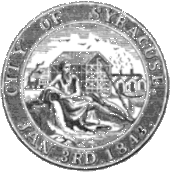
The original settlement went through several name changes until 1824, first being called 'Salt Point' (1780), then 'Webster's Landing' (1786), 'Bogardus Corners' (1796), 'Milan' (1809), 'South Salina' (1812), 'Cossits ao Corners' (1814), and 'Corinth' (1817). The U.S. Postal Service rejected the name Corinth upon its application for a post office, stating there was already a post office by this name in New York.
The village of Syracuse was laid out into streets and lots in 1819, but the first election of village officers did not occur until 1825. At the time of incorporation, the village had 15 merchants, one newspaper, a fire department, and several small industries. The first schoolhouse was erected in 1820, the first church (Baptist) was built in 1821, and the First Presbyterian Church in 1824. The first grist mill occupied the ground where Syracuse High School later stood. This was also the site of Central High School. The village of Lodi consisted of a cluster of homes, groceries, and small businesses situated on the Erie Canal, east of Syracuse.
Because of similarities such as a salt industry and a neighboring village named Salina, the name Syracuse was chosen by village planner, John Wilkinson, after Syracuse, Sicily. In 1825, the village of Syracuse was officially incorporated. By 1832, the city had four wards.
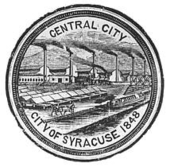
During the winter of 1847 ae48 discussions about the incorporation of the three villages, Salina, Lodi and Syracuse began.
The period between 1830 and the incorporation of the city in 1847 was one of remarkable growth in all directions in the village of Syracuse. From a population of about 7,000 in 1830 it grew to 11,014 in 1840, and to 22,271 in 1850. Business industries multiplied, churches and schools were established, and from the small community which has been described, living in quite primitive conditions, Syracuse became a large and thriving village, with a reputation for enterprise and progressiveness that was reaching out over New York State.
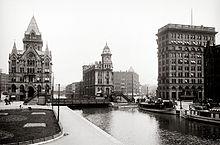
The opening of the Erie Canal in 1825 caused a steep increase in the sale of salt, not only because of the improved and lower cost of transportation, but additionally, the ease of canal shipment caused New York State farms to change from wheat to pork production and curing pork required a lot of salt.
After the War of 1812, it became difficult to obtain salt from abroad and commercial salt production became an important Syracuse industry. The Erie Canal allowed the bulky and low-priced Onondaga salt to be transported to Chicago and beyond via the Great Lakes relatively quickly and inexpensively.
By 1830, the Erie Canal, which ran through the village, was completed. The Village of Syracuse and the Village of Salina were combined into the City of Syracuse on December 14, 1847. Harvey Baldwin was the first mayor of the new city.
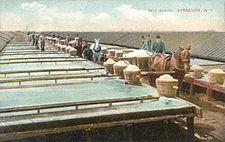
The Jesuit missionaries visiting the Syracuse, New York region in the mid 17th century reported salty brine springs around the southern end of "Salt Lake", known today as Onondaga Lake. The 1788 Treaty of Fort Stanwix (1784), and the subsequent designation of the area by the State of New York as the Onondaga Salt Springs Reservation, provided the basis for commercial salt production from the late 18th century through the early 20th century.
The end result of the French and Indian War was the Treaty of Fort Stanwix (1784) enacted by the United States on October 22, 1784. The lands of the natives were distributed soon after. In 1788, the lands around Onondaga Lake were transferred from the Onondaga Nation to local salt producers with the stipulation that the property would be used to produce salt "for the common use of everyone."
Until 1900, the bulk of the salt used in the United States came from Syracuse.
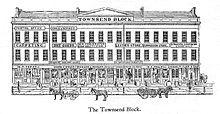
Syracuse became an active center for the abolitionist movement, due in large part to the influence of Gerrit Smith and a group allied with him, mostly associated with the Unitarian Church and their pastor The Reverend Samuel May in Syracuse, as well as with Quakers in nearby Skaneateles, supported as well by abolitionists in many other religious congregations. Prior to the Civil War, due to the work of Jermain Wesley Loguen and others in defiance of federal law, Syracuse was known as the "great central depot on the Underground Railroad".
On October 1, 1851, William Henry, a freed slave known as "Jerry" was arrested under the Fugitive Slave Law. The anti-slavery Liberty Party was holding its state convention in the city, and when word of the arrest spread, several hundred abolitionists including Charles Augustus Wheaton broke into the city jail and freed Jerry. The event came to be widely known as the Jerry Rescue. In the aftermath, the Congregationalist minister Samuel Ringgold Ward had to flee to Canada to escape persecution because of his participation.
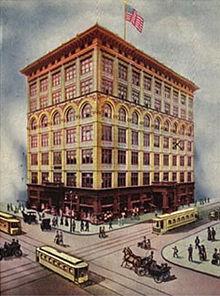
The first telegraphic message was received in the city via Albany, New York in 1840. The population by 1848 had grown to 18,741.
During 1850, Henry A. Dillare, erected a five-story block where the McCarthy Department Store later stood. The city market in the City Hall building was abandoned the latter part of 1852.
By 1853, the city was divided into eight wards and in 1856, the ten city banks reported an aggregate capital of $1,535,000.
On May 23, 1869, the Onondaga County Savings Bank building was opened for business. The first levy for city taxes collected was $58,441. John Greenway, brewer, gave a public barbecue in Clinton Square on New Year's Day, 1870.
During 1875, there were 200 smallpox deaths in the city. In 1879, the city population had grown to 62,243.
The telephone was first exhibited in Syracuse on June 12, 1879. The cornerstone of the County Clerk's building was laid on August 11, 1880. Shortly after, the electric light system was introduced into the central parts of the city in 1883.
Geddes was annexed to the city on May 17, 1886 and on February 3, 1887, the village of Danforth became part of the city.
By 1887, the city was divided into 11 wards, by 1891 it had split to 14 and by 1893 there were 19 wards. The City Hall building was completed in 1892.
The New York State Fair permanently located in the city limits in 1888.
James Geddes was hired in 1797 to survey Onondaga Salt Springs Reservation and lay out the first road in Salt Point.
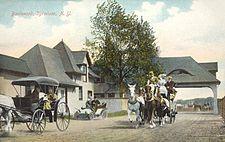
In 1798, Salt Point became the village of Salina. The Surveyor-General, Simeon DeWitt employed Geddes to design the streets. Although Geddes had no formal training in surveying, DeWitt saw great potential in him. Soon Geddes sold his interest in the Geddes salt works to pursue other interests and surveying continued to be an important role for much of his life.
Geddes later surveyed and laid out the village of Geddes with approximately 20 lots on either side of West Genesee Street in 1807.
In 1812, early settler Comfort Tyler, then a state assemblyman, secured a charter for the Seneca Turnpike Company. With $100,000 he initiated the construction of a turnpike road (a toll road) on the old state road between Utica and Canandaigua. The road was finished in late 1812 and was "fairly flat and improved communications between the eastern and western areas" and was commonly known as the Seneca Turnpike. This road is known today as Genesee Street in Syracuse.
From 1803 through 1804, the Cherry Valley Turnpike, which passed through Cazenovia and intersected the Seneca Turnpike at Manlius was under construction. In 1807, roads around Onondaga Hill and Oswego to Salina were in the planning stages.
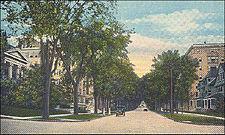
A road was approved in 1809 from Free Street and Salt Street in Salina to the town of Cicero. The Cold Spring Road was approved in 1817, from Liverpool to the Seneca River at Cold Springs. In 1820, Geddes laid a road between Salina and the Geddes Works. To deal with the swampy bogs he first filled the area with brush and debris from the swamp. This road is now called Hiawatha Boulevard.
A swing bridge in Salina Street was built in 1874, according to an act of the Legislature that year. The first asphalt pavement in the city was laid in 1880.
James Street was an exclusive residential thoroughfare by the late 19th century. The architectural styles of its homes varied from modified Spanish Revival and Italian Renaissance Revival to Greek Revival and Queen Anne, from Victorian Gothic to Georgian Colonial. West Genesee Street, part of the original Genesee Turnpike, had been through many changes since the "old red mill" was built on the banks of Onondaga Creek. For years, it was a choice residential street. Later, with the invention of the automobile, it became a busy commercial thoroughfare.
The official opening of the new State Fair Boulevard took place on September 2, 1916. Visitors to the New York State Fair that year were "pleased" with the 40-foot (12 m) wide smooth concrete surface of the road that ran from Hiawatha Avenue to the fairgrounds. The old boulevard had caused much trouble with its "mud holes and sticky surface when wet and clouds of dust when dry."
Exhibitors at the fair who had to haul over the boulevard found their trips cut in half and "the horses drawing loads will be saved greatly."
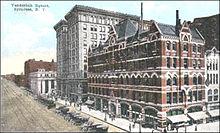
The first railroad station in Syracuse was in Vanderbilt Square, along East Washington Street between Salina and Warren Streets which was named for Commodore Cornelius Vanderbilt, a railroad magnate and millionaire whose New York Central Railroad "dominated Washington Street for 100 years."
From 1839 on, Syracuse life for many years revolved around Vanderbilt Square, the magnet was the railroad station, and the hostelries that grew up around it. In the old station Henry Clay was welcomed on his visit to the New York State Fair in 1849. Daniel Webster, General Winfield Scott, Louis Kossuth, John Brown, Stephen A. Douglas, and other notables were greeted there.
The first street railway was built in Salina street in 1859 and Syracuse was soon known "far and wide" as the city where the trains passed through the middle of downtown. Travelers caught "intimate glimpses" of Syracuse, its people, stores and houses as the trains slowed on their way through town.
On February 18, 1861, Abraham Lincoln, on the way to his inauguration, bowed from a coach platform. and on April 26, 1865, his funeral train stopped for 30 minutes.
During the 1930s, the city's fourth rail station was constructed along Erie Boulevard East when the rail line through Syracuse was elevated. In Syracuse, the trains ran through the center of downtown, along Washington Street. That elevated section later was abandoned and replaced by Interstate 690.
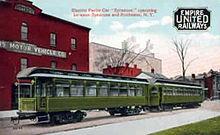
In addition to the multitude of rail services in the area, interurban and streetcar railway in Syracuse flourished in the city until the automobile, airplane and bus took their place by the early 1940s.
The trolley or streetcar served travel within the city limits of Syracuse as early as 1859. In the early days they were either horse-drawn or fueled by steam and by the end of the 19th century they were electric driven. The city was one of the first in the United States to adopt electricity as a transportation motive power.
Interurban were suburban railways with rights-of-way for higher speed traffic. They linked the city with the countryside which allowed people who lived in the suburbs and farming communities to work in Syracuse. The era was short-lived, however, lasting just over 40 years. The first interurban line was built in the city in 1885 with services to Oneida and the last line completed to Oswego in 1911. By 1932, "every bit" of track had been removed and the entire era was over.
By 1839, the "turbulent element" of the population became too unruly to be controlled by the old constabulary, and a committee consisting of the trustees of the village, with Thomas T. Davis, John Wilkinson and David S. Colvin, was appointed early in 1840 "to report amendments to the ordinances that will give the village a more vigorous police."
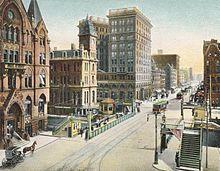
In May 1839, it was resolved by the trustees that "there shall hereafter be a police justice in Syracuse, who shall be appointed in the same manner as the judges of the County Courts," and an act of Legislature was procured for this purpose.
The first gas company in the city began business in 1849.
The Syracuse Fire Department built Engine House 1 in 1859 and a watch tower was constructed in the rear of Engine House 2 in 1862. The department added two steam engines to their fleet in 1866. By 1878, expenses for the fire department were $30,000 per year.
The matter of a stable city water supply from either Tully Lake or Skaneateles Lake was discussed during 1870 and 1871. Skaneateles Lake was chosen and in 1894 the modern water supply system was finally operational.

The salt industry declined after the Civil War, but a new manufacturing industry arose in its place. Manufacturing proliferated in Syracuse, New York from the late 1870s through the early 20th century, a period known as the Industrial Revolution. Franklin Chase, author of the 1924 history "Syracuse and Its Environs," summed up the early 20th century in Syracuse with this claim: "In truth, Syracuse manufactured more different articles numerically than even New York City itself."
During the early years, numerous businesses and stores were established, including the Franklin Automobile Company, which produced automobiles with air-cooled engines. In 1902, the Franklin (automobile) Model A attained the distinction of being the first four-cylinder automobile produced in the United States.
Other important industries included the Crouse-Hinds Company, manufacturer of traffic signals; and the Craftsman Workshops, the center of Gustav Stickley's handmade furniture empire.
The first Solvay Process Company plant in the United States, was erected on the southeastern shore of Onondaga lake in 1884 and the village was given the name Solvay, New York to commemorate its inventor, Ernest Solvay. In 1861, he developed the ammonia-soda process for the manufacture of soda ash (anhydrous sodium carbonate, a rare chemical called natrite, to distinguish it from natural natron of antiquity) from brine wells dug in the southern end of Tully valley (as a source of sodium chloride) and limestone (as a source of calcium carbonate). The process was an improvement over the earlier Leblanc process.
The Syracuse Solvay plant was the incubator for a large chemical industry complex owned by Allied Signal in Syracuse, the result of which made Onondaga Lake the most polluted in the nation.
The first public education in the area occurred in 1797 in Salt Point, later the first ward of the city, where school was held in a salt block, a special building erected for processing salt. The first district school organized within the present city limits was in the village of Geddes where the earliest known schoolhouse was erected in 1804 on the site that was later occupied by Porter School.
The first schoolhouse to annex into the city was constructed in 1805 in the town of Salina which was incorporated in 1809. The building, designated as "No. 1," was constructed "according to the fashion of the day" with the faces of the children turned toward the four walls and the instructor in the middle of the room. The village of Salina was incorporated in 1824 and the school remained "No. 1" until the city of Syracuse was incorporated in 1848. At that time, the spring term opened with about 50 pupils in all grades of the "elementary studies." During the winter, the older students, many of them larger than the teacher, increased the total to over 100. The number increased so that it became necessary to "seat some of the pupils on the wood-pile."
The first school house in the village of Syracuse limits was built on Church Street (West Willow Street) at the corner of Franklin Street about 1826. Local schools passed into the control of the Syracuse Board of Education in the spring of 1848.
The first high school building was erected in 1868 and was called High School.
Night schools for adults were established in the 1890. By 1936, under the depression era WPA, funding was provided to hire 300 teachers to instruct 15,000 adults.
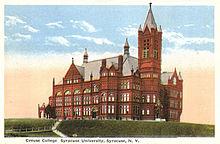
In 1930, the city opened a special school for crippled children and by 1932 the Children's court was established.
Syracuse University was chartered in 1870 as a Methodist-Episcopal institution and opened its doors for instruction in September 1871.
Geneva Medical College was founded in 1834 in Geneva, New York. It is now known as Upstate Medical University, the most prestigious medical college in the Syracuse area, one of only four in the State University of New York system, and one of only five medical schools in the state north of New York City.
The first public hospital opened in the city in 1870. The Milbank Memorial Fund, provided approximately $450,000 for public health projects during a nine-year period from 1923 through 1931 and "helped give Syracuse a high rank in health standards."
The Syracuse Telephonic Exchange was founded after Frederick C. Brower introduced the Bell telephone to Syracuse in 1878. He had seen the device exhibited at the Philadelphia Exposition of 1876 and secured Central New York rights from the Bell system. His father, Hiram C. Brower, was credited with installing the first "speaking tubes" in Syracuse and also the first enunciators and began the first telephone exchange which had about 1,000 subscribers.
During 1879, Mathew J. Myers, who operated a local telegraph and messenger service in the city, opened an exchange in the tower of the Gridley Building after sub-leasing the rights from Brower. D. L. Pyke, superintendent of Western Union, opened a rival exchange in the Wieting Block in Downtown Syracuse. During 1880, the two rival exchanges merged and named the Syracuse Telephonic Exchange which was eventually consolidated into the New York Telephone Company.
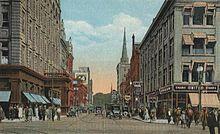
By the 20th century, Syracuse University was no longer sectarian and had grown from a few classrooms located in downtown Syracuse into a major research institution. It is nationally recognized for its college basketball, college football, and college lacrosse teams. In 1911, under the leadership of Syracuse University trustee, Louis Marshall, the New York State College of Forestry was re-established in close association with Syracuse University; it since has evolved into the SUNY-ESF. Le Moyne College was founded in 1946; Onondaga Community College in 1962.
World War II sparked significant industrial expansion in the area: specialty steel, fasteners, custom machining. After the war, two of the Big Three automobile manufacturers (General Motors & Chrysler) had major operations in the area. Syracuse was headquarters for Carrier Corporation, Crouse-Hinds traffic signal manufacturing, and General Electric had its main television manufacturing plant at Electronics Parkway in Syracuse.
Syracuse's population peaked at 221,000 in 1950. Immigration from abroad introduced many ethnic groups to the city, particularly German, Jewish, Irish, Italian, and Polish. African Americans had lived in Syracuse since Revolutionary War days, but between 1940 and 1960, some of the three million African Americans who migrated from the south to northern cities also settled in Syracuse. In the 1980s, many immigrants from Africa and Central America also moved to Syracuse, as they did to many northern cities ae sometimes under the auspices of several religious charities. However, these new Syracusans could not make up for the flow of residents out of Syracuse, either to its suburbs or out of state, due to job loss.
Much of the city fabric changed after World War II, although Pioneer Homes, one of the earliest government housing projects in the US, had been completed earlier, in 1941. Many of Syracuse's landmark buildings were demolished in the 1950s and 1960s. The federal Urban Renewal program cleared large sectors that remained undeveloped for many decades, although several new museums and government buildings were built.
The manufacturing industry in Syracuse began to falter in the 1970s. Many small businesses failed during this time, which contributed to an already increasing unemployment rate. Rockwell International moved their factory outside New York state. General Electric moved its television manufacturing operations to Suffolk, Virginia and later to Singapore. The Carrier Corporation moved its headquarters out of Syracuse and outsourced manufacturing to Asian locations. Nevertheless, although city population has declined since 1950, the Syracuse metropolitan area population has remained fairly stable, even growing by 2.5 percent since 1970. While this growth rate is greater than much of Upstate New York, it is far below the national average during that period.

Syracuse is located at 43 °2 a²49 a³N 76 °8 a²40 a³W / 43.04694 °N 76.14444 °W / 43.04694; -76.14444 (43.046899, na76.144423).
According to the United States Census Bureau, the city has a total area of 25.6 square miles (66 km2), of which, 25.1 square miles (65 km2) of it is land and 0.6 square miles (1.6 km2) of it (2.15%) is water.
The city stands at the northeast corner of the Finger Lakes Region. The city has many neighborhoods which were originally various villages that joined the city over the years. Although the central part of Syracuse is flat, many of its neighborhoods are located on small hills such as University Hill and Tipperary Hill. Land to the north of Syracuse is generally flat while land to the south is hilly.
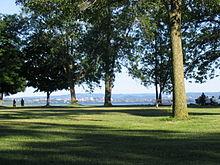
About 27 percent of Syracuse's land area is covered by 890,000 trees ae a higher percentage than in Albany, Rochester or Buffalo. This is despite the Labor Day Storm of 1998, a derecho which destroyed approximately 30,000 trees. The sugar maple accounts for 14.2 percent of Syracuse's trees, followed by the Northern white cedar (9.8 percent) and the European buckthorn (6.8 percent). The most common street tree is the Norway maple (24.3 percent) followed by the honey locust (9.3 percent). The densest tree cover in Syracuse is in the two Valley neighborhoods, with 46.6 percent of their land covered by trees. The lowest tree cover percentage is found downtown, which consists of only 4.6 percent trees.
Syracuse's main water source is Skaneateles Lake, one of the country's cleanest lakes, located 15 miles (24 km) southwest of the city. Water from nearby Onondaga Lake is not drinkable due to industrial dumping that spanned many decades, leaving the lake heavily polluted. Incoming water is left unfiltered, and chlorine is added to prevent bacterial growth. For periods of drought, there is also a backup line which uses water from Lake Ontario.
Onondaga Creek, a waterway that runs through downtown, flows northward through the city. There are plans and aspirations to create a creek walk that will connect the Lakefront and Inner Harbor to Franklin Square, Armory Square, The Valley, and ultimately the Onondaga Nation. The creek is navigable, yet can be quite a challenge as its channelized nature speeds up its flow, particularly in the spring, when it may be dangerous. Drownings of youngsters resulted in fencing of the creek through some residential areas.
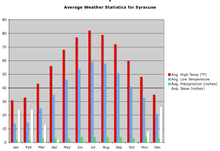
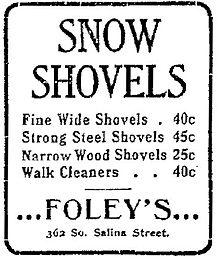
Syracuse has a humid continental climate (Koppen Dfb) and is known for its snowfall. Boasting 121.2 inches (308 cm) on average, the Syracuse metro area receives more snow on average than any other large city in the United States. Syracuse continually wins the Golden Snowball Award, among Upstate cities. Its record so far is 192.1 inches (488 cm). The high snowfall is a result of the city receiving both lake effect from nearby Lake Ontario and nor'easter snow. Snow most often falls in small (about 1 ae3 inches/2.5 ae7.6 centimetres), almost daily doses, over a period of several days. Larger snowfalls do occur occasionally, and even more so in the northern suburbs.
One notable blizzard was the Blizzard of 1993, during which 42.9 inches (109 cm) fell on the city within 48 hours, with 35.6 inches (90 cm) falling within the first 24 hours. Syracuse received more snow than any other city in the country during this storm, which shattered a total of eight local records, including the most snow in a single snowstorm.
A second notable snowfall was the Blizzard of 1966, with 42.3 inches (107 cm). The Blizzard of '58 occurred in February (16 ae17th) across Oswego and Onondaga counties. This storm was an actual blizzard due to the high winds, blowing snow and cold. 26.1 inches (66 cm) of snow was measured at Syracuse N.Y. and drifts reached 20 feet (600 cm) in Oswego County. (See Thirtieth Publication of the Oswego County Historical Society, (1969) and The Climate and Snow Climatology of Oswego N.Y., (1971)
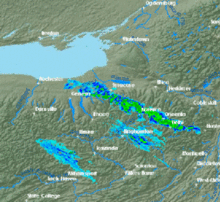
January 2004 was the snowiest month ever in Syracuse, with a record 78.1 inches (198 cm) recorded in 31 days. December 2010 became Syracuse's second snowiest December ever on record with 72.8 inches (184.9 cm) and 45.1 inches (114.6 cm) fell in 4 days. In February 1958, Syracuse shivered under a white blanket that averaged 4 feet (120 cm) on February 19. Syracuse declared a snow emergency under a new law that allowed municipalities to demand that streets be cleared of vehicles to help with plowing operations.
Syracuse's hottest month is historically July, with an average high temperature of 82 °F (28 °C), while its coldest month is historically January, with an average high temperature of 31 °F ( na1 °C). The Record high of 102 °F (39 °C) was recorded on July 9, 1936 and record low of na26 °F ( na32 °C) has been witnessed three times since 1922, the last being February 18, 1979.
While the average high during summer is around the low 80s, when adding humidity, the apparent temperature highs extend upward in the range of mid-80s to mid-90s in the city. Days just shy of 100 °F (38 °C), such as 96 or 97 °F (36 °C), are not uncommon in and around the city with the humidity factored in. However, days above 100 °F (38 °C) are more rare, even with humidity taken into account.
A few recent summers in Syracuse have been warmer than previous ones in the city and, like in some other places in the nation, previous records have been broken. For example, the summers of 2005 and 2002 were, respectively, the hottest and second-hottest summers on record.
As of the census of 2010, there were 145,170 people,and 56,445 households. The population density was 5,796.8 people per square mile (2,266.8/km ²). There were 64,356 housing units.
The racial and ethnic makeup of the city reported in the 2010 Census was as follows: 56.0% White, 29.5% African American, 1.1% Native American, 5.5% Asian, and
There were 56,445 households out of which 28.8% had children under the age of 18 living with them, 23.6% were married couples living together, 20.8% had a female householder with no husband present, and 50.4% were non-families. 29% of all households were made up of individuals and 19.8% had someone living alone who was 65 years of age or older. The average household size was 2.31 and the average family size was 3.14.
In the city the population was spread out with 30.4% under the age of 18, 16.8% from 18 to 24, 30.4% from 25 to 44, 21.3% from 45 to 64, and 10.6% who were 65 years of age or older. The median age was 29.7 years.
The median income for a household in the city was $22,715, and the median income for a family was $37,384. Males had a median income of $36,021 versus $30,846 for females. The per capita income was $17,866. About 25.6% of families and 31.1% of the population were below the poverty line, including 44.1% of those under age 18 and 12.5% of those age 65 or over.
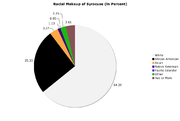
Over the course of 400 years, immigrants from all over the world have been attracted to the Central New York area, including the African, Asian, Bosnian, British, French, German, Greek, Hispanic (in particular Puerto Rican), Irish, Italian, Jewish, Lebanese, Pacific Islander, Polish, Syrian, Ukrainian, and Welsh communities. Native Americans also continue to have a presence in the area, as they have for centuries.
Recent demographics indicate that the largest ancestries represented in the city includes African American (27.9%), Irish (15.9%), Italian (14.1%), German (12.2%), English (7.6%), Hispanic (6.5%), Polish (5.0%), Asian (4.0%) and Pacific Islander (1.1%).
Syracuse's economy has faced challenges over the past decades as industrial jobs have left the area. The number of local and state government jobs also has been declining for several years. Syracuse's top employers are now primarily in education and the service industry. University Hill is Syracuse's fastest growing neighborhood, fueled by expansions by Syracuse University and Upstate Medical University (a division of the State University of New York), as well as dozens of small medical office complexes.
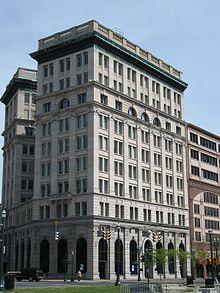
The top ten employers in the Syracuse region and the size of their workforce according to syracusecentral.com:
Bristol-Myers Squibb, founded by alums of nearby Hamilton College, has a complex near the Eastwood district. Time Warner Cable has based one of its divisions in Syracuse.
Today the Syracuse area has few extremely large employers, but rather many smaller ones. Eight of the area's top eleven employers are in education or the service industry, rather than in manufacturing.
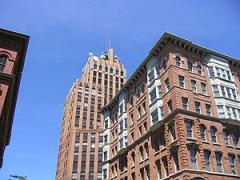
Since 1927 the State Tower Building has been the tallest in Syracuse.
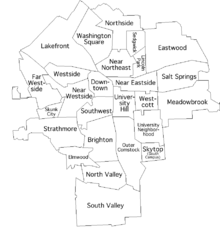
The City of Syracuse officially recognizes 26 neighborhoods within its boundaries. Some of these have small additional neighborhoods and districts inside of them. In addition, Syracuse also owns and operates Syracuse Hancock International Airport, located on the territory of four towns north of the city.
Syracuse's neighborhoods reflect the historically divided population. Traditionally, Irish, Polish and Ukrainian Americans settled on its westside; Jews on its eastside; German and Italian Americans on the northside; and African-Americans on its southside.
In addition to the dominant Destiny USA shopping area in the Syracuse's Lakefront neighborhood, many of the city's more traditional neighborhoods continue to have active business districts:
Word Count: 7148





